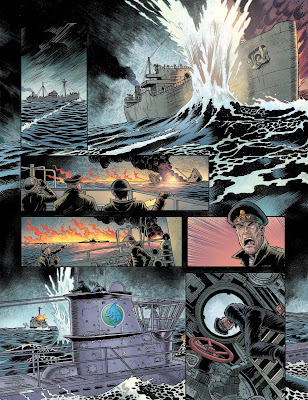It's back for a five issue mini-series from Rebellion Publishing.... Battle Action, 2000AD publisher’s relaunch of the title inspired by two classic British weekly comics, Battle Picture Weekly (aka Battle) and Action, returns as a five-issue miniseries, with writer Garth Ennis playing a principal role in its latest incarnation.
Battle Picture Weekly, still holds an exalted position in my memory - in fact it is probably my favourite comic book ever. But besides that Battle displayed a stunning use of the medium over its run and of course gave us a genuine comic book masterpiece in Charley's War - but more on that seminal strip later.
Battle was launched in answer to rival D C Thompson's successful war strip title, Warlord and although born out of imitation Battle did better Warlord and is perhaps one of the, if not THE, most important British comic titles ever.
 Battle's
answer to Warlord's main character, Lord Peter Flint was Mike Nelson
codenamed The Eagle - however readers preferred the more gritty strips
in Battle and Mike Nelson, although featuring in several series of
adventures, was soon dropped.
Battle's
answer to Warlord's main character, Lord Peter Flint was Mike Nelson
codenamed The Eagle - however readers preferred the more gritty strips
in Battle and Mike Nelson, although featuring in several series of
adventures, was soon dropped. Early stars of Battle Picture Weekly were D-Day Dawson, The Bootneck Boy and the truly exceptional Rat Pack which was based very much on the popular movie, The Dirty Dozen.
So well remebered are The Rat Pack that Titan Books have a trade paperback collection that collects together many of their most popular stories.
 |
| which one is Lee Marvin? |
Another early strip that was hugely popular was D D Dawson - it told of Sgt. Steve Dawson who took a bullet during the D-Day landings but survived. However the bullet moved closer to his heart with every adventure and he knows that it will inevitably kill him. And so he vows to fight on until his own personal D-Day finally arrives. And arrive it did in the issue dated 22 Jan 1977 when the character finally went down. The next two scans depict D Day Dawson's last adventure - click on the images for a bigger readable version.

The comic merged other titles into it during its long run and the details are:
- Battle Picture Weekly (8 March 1975 - 16 October 1976)
- Battle Picture Weekly and Valiant (23 October 1976 - 12 November 1977)
- Battle Action (19 November 1977 - 20 February 1982)
- Battle (27 February 1982 - 1 October 1983)
- Battle Action Force (8 October 1983 - 29 November 1986)
- Battle (6 December 1986 - 17 January 1987)
- Battle Storm Force (24 January 1987 - 23 January 1988)
The world of Battle was a non-PC world where the Americans were Yanks, the Japanese were Japs, the Germans were Nazis and the British were Limeys, but it wasn't always as clear cut and one strip in particular, Charley's War created by Pat Mills with almost photographic artwork from Joe Colquhoun, was an anti-war strip in a boys war comic and today stands as a true masterpiece of British comics. Titan have published several deluxe hardback volumes collecting the stories with still more to come.
 | ||
| True depth in the comic book medium |
 |
| TITAN'S CHARLEY'S WAR COLLECTION |
Battle truly was an exceptional comic book and it's great that the legacy is still remembered and felt even today. It may have started off as a typical gung ho style comic book but the skill of the creators soon led it into avenues previously unexplored in the comic book medium. It was incredible reading for a young kid to be presented with war in a realistic fashion in strips such as Charley's War and Johnny Red. to be presented with the unglamorous truth and to discover that bullets really did hurt and that the glory of fighting for one's country soon becomes secondary to surviving when the reality of war is felt.
 |
| Oh you are awful but I do like you! |
To fully cover the importance of Battle would take more than one, two or even several blog articles - indeed a full scale book would be called for, but the article here is merely a taster of a time when British Comics really were a formidable creative force.




















